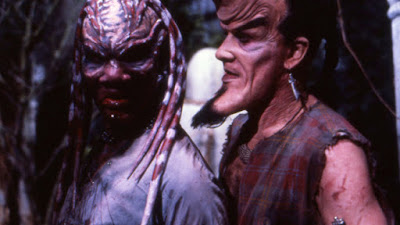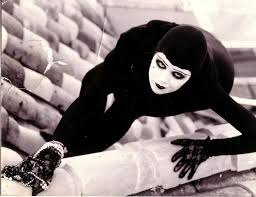PHENOMENALITY: (1) *marvelous*, (2) *naturalistic*
MYTHICITY: (1) *fair,* (2) *poor*
FRYEAN MYTHOS: *adventure*
CAMPBELLIAN FUNCTION: *sociological*
When I reviewed DRINK’s sequel GOLDEN SWALLOW in this 2016 review, I hadn’t watched DRINK of some years. In my SWALLOW review I observed, as others before me had, that the character of Golden Swallow was somewhat overshadowed by the two males fighting over her. Now, upon re-watching DRINK, I see a similar situation in that film, where a male support-character takes on such importance that he almost becomes a co-equal partner in the narrative. However, whereas the sequel may have shifted focus from the central heroine simply because its director Chang Cheh wasn’t fond of female protagonists, the first film’s director/co-writer King Hu seems to have just allowed his script to get somewhat disjointed. Yet in both films, I would still view the Golden Swallow to be the “engine” who keeps the narrative running, not unlike America’s two “Nyoka” serials, where male characters do a lot of heavy lifting in terms of fight-scenes, but the female hero is still the central presence.
A disjointed narrative is certainly not the only aspect of DRINK that got passed on to the hundreds of Hong Kong kung fu films to follow. Swallow, essayed by former dancer Cheng Pei Pei, seems to be one of the first kung-fu heroines, as well as one of the first to travel around masquerading as a man. Indeed, many of her enemies believes that Swallow is a man, known far and wide for carrying out the will of “his” magistrate-father. (Her imposture never seems convincing, and even less so when one finds out that Swallow has a small coterie of warriors, also female, and also presumably pretending to be men.) In any case, Swallow’s father sentences the chief of a bandit gang to death. The gang retaliates by kidnapping the judge’s other son and using him to ransom their leader. Swallow, knowing that her upstanding father will not deal with criminals, arranges a meeting with the gang, hoping to liberate her brother.
From then on, Swallow has various fights with the bandits, and at least one, in which she takes on a dozen foes with her sword, seems like the archetypal kung-fu scenario. That said, the heroine survives in part thanks to the help of a “guardian angel,” an apparent reprobate named Drunk Cat, who represents HK cinema’s abiding love of drunkard-heroes. Cat’s motives for helping Swallow are rather obscure. However, some scenes establish that he’s a former adherent of a kung-fu temple, where the bandits happen to be holed up. The abbot of the temple, Tiao Ching-tang, has allied himself to the bandits, and although Cat owes Tiao a debt of honor, the drunk-hero may have linked up with Swallow because he anticipates having it out with the abbot.
Another familiar trope is that of a sense of an almost-romance between the female hero and her male aide, though the script stays away from explicit eroticism. In the last third Swallow and her female soldiers lay waste to the bandits and rescue Swallow’s brother. However, the abbot becomes the final threat, and like a lot of older kung-fu masters throughout HK cinema, he has supernatural powers from his rigorous training. When Swallow stabs Tiao, her weapon simply won’t pierce his torso, though significantly he doesn’t allow her to strike as his head. When Tiao and Cat square off and start shooting at each other with blasts of compressed air, I wondered if they were using some anachronistic technology, only to realize that this was King Hu’s way of depicting two kung fu masters using blasts of “chi.” On a minor note, one of Swallow’s female warriors is played by Angela Pan, who went on a measure of fame for dismasting the One Armed Swordsman.
After the success of DRINK, Hu attempted a more ambitious project, A TOUCH OF ZEN, which failed at the Asian box office. His next two films were more standard kung-fu exploits, but the first, THE FATE OF LEE KHAN, was anything but a return to form.
Even a casual student of Chinese cinema should discern a cultural tendency to build plots so labyrinthine one often can’t follow who’s doing what to whom. KHAN is named for a 13th-century general who’s a major asset in the Mongol occupation of China. When the Chinese resistance movement learns that Khan and his sister plan to stay at a particular inn, a team of agents—one man and four women—masquerade as the owner of the inn and his four maids. The rebels hope to steal a map showing Khan’s battle plans, though they don’t seem all that careful about keeping the general from learning about their mission, which I would think would negate the whole project.
I suppose the five resistance fighters are the protagonists, but they’re all pretty boring, despite the fact that one of them is played by future kung-fu diva Angela Mao. But Mao doesn’t shine here, any more than the two villains, the sister being played by yet another diva, Hsu Feng. A DVD commentary asserts that this vehicle is notable for King Hu’s emphasis on “realism” in the kung-fu genre, but that only works if one accepts “tedium” as a definition of realism. To be sure, KHAN is an entirely naturalistic film, but there are many films in the genre that stay within that phenomenality but still deliver strong characters, as with the aforementioned ONE ARMED SWORDSMAN. It did occur to me that there might subtleties in KHAN’s depiction of archaic Chinese culture that had special value for Chinese viewers, but that possibility doesn’t make the film any more entertaining to an outsider. In the final analysis KHAN is interesting only for its place in the respective careers of King Hu, Angela Mao and Hsu Feng.















